Last updated on March 22nd, 2025 at 10:50 am
In this comprehensive guide, we’ll delve into the art of crocheting a Double Crochet Ripple Stitch, a timeless technique that adds elegance and depth to your creations.
If you’ve ever been captivated by the mesmerizing waves and ripples in crochet projects and wondered how to achieve this charming effect, then you’re in for a treat.
Crocheting is a delightful craft that allows you to turn yarn into intricate designs, each stitch showcasing your creativity and skill. Whether you’re an experienced crocheter seeking new challenges or a confident beginner eager to dive into the wonders of this craft, learning the Double Crochet Ripple Stitch is a perfect starting point.
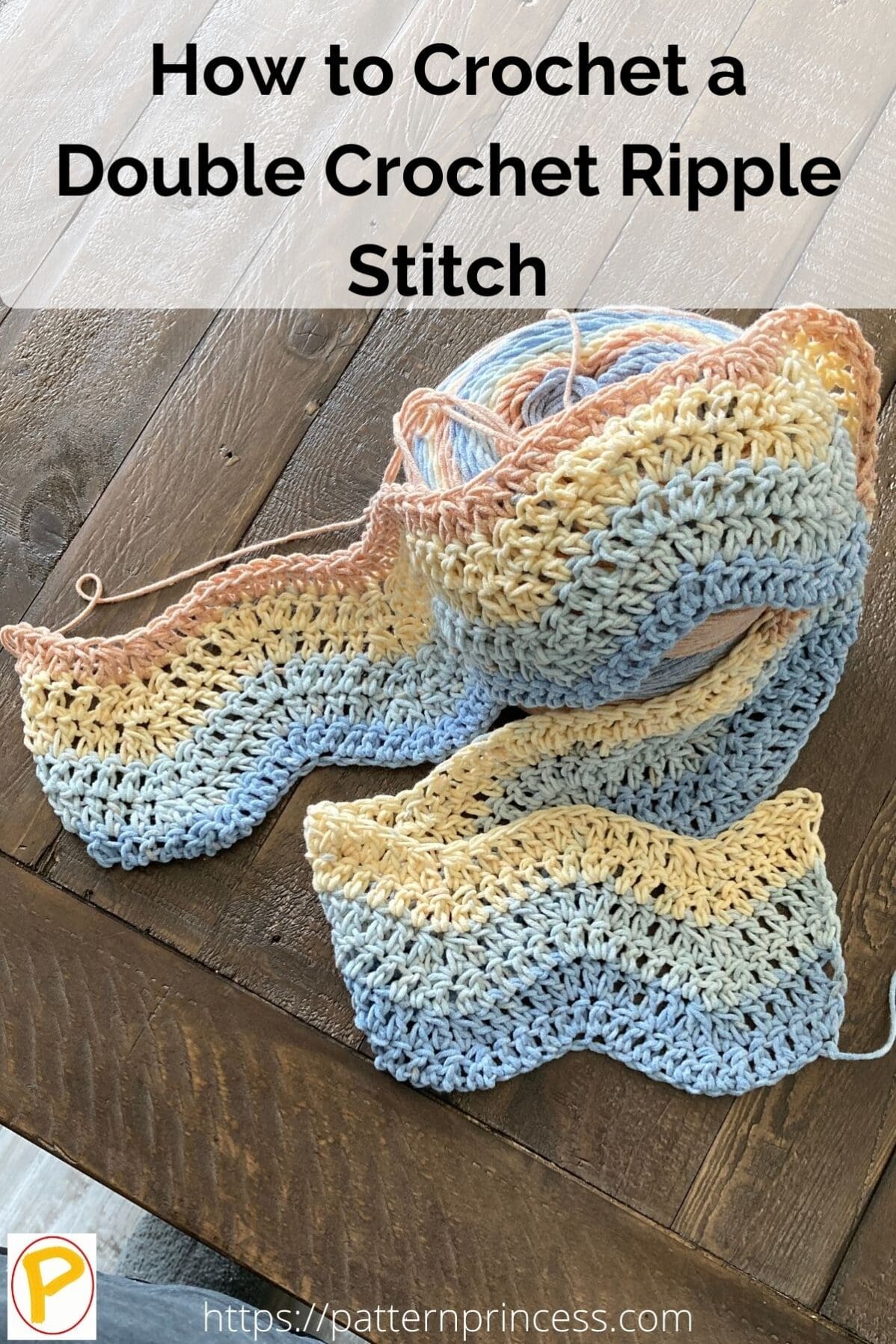
Post contains affiliate links, and we earn commissions if you shop through the links on this page. For more information, please read the disclosure section under the About Us page.
Unraveling the Magic: How to Crochet a Double Crochet Ripple Stitch
Throughout history, ripples have been a favorite motif among crocheters, evoking the gentle undulation of ocean waves or the rhythmic flow of a meandering river. With its simplicity and versatility, the Ripple Stitch remains a beloved classic, as it can be adapted to create everything from cozy blankets and scarves to stunning garments and home decor.
One Row Repeat Throughout
This is truly a super easy crochet project with its repeat of row two throughout. You’ll be sure to master this delightful stitch pattern.
We’ll show you how to crochet this stitch. After the written pattern, you will find links for how-to crochet video tutorials for both a left hand and right hand crocheter. Further, in an effort to break this down into easy-to-follow instructions, there are photos to help with understanding the written crochet pattern.
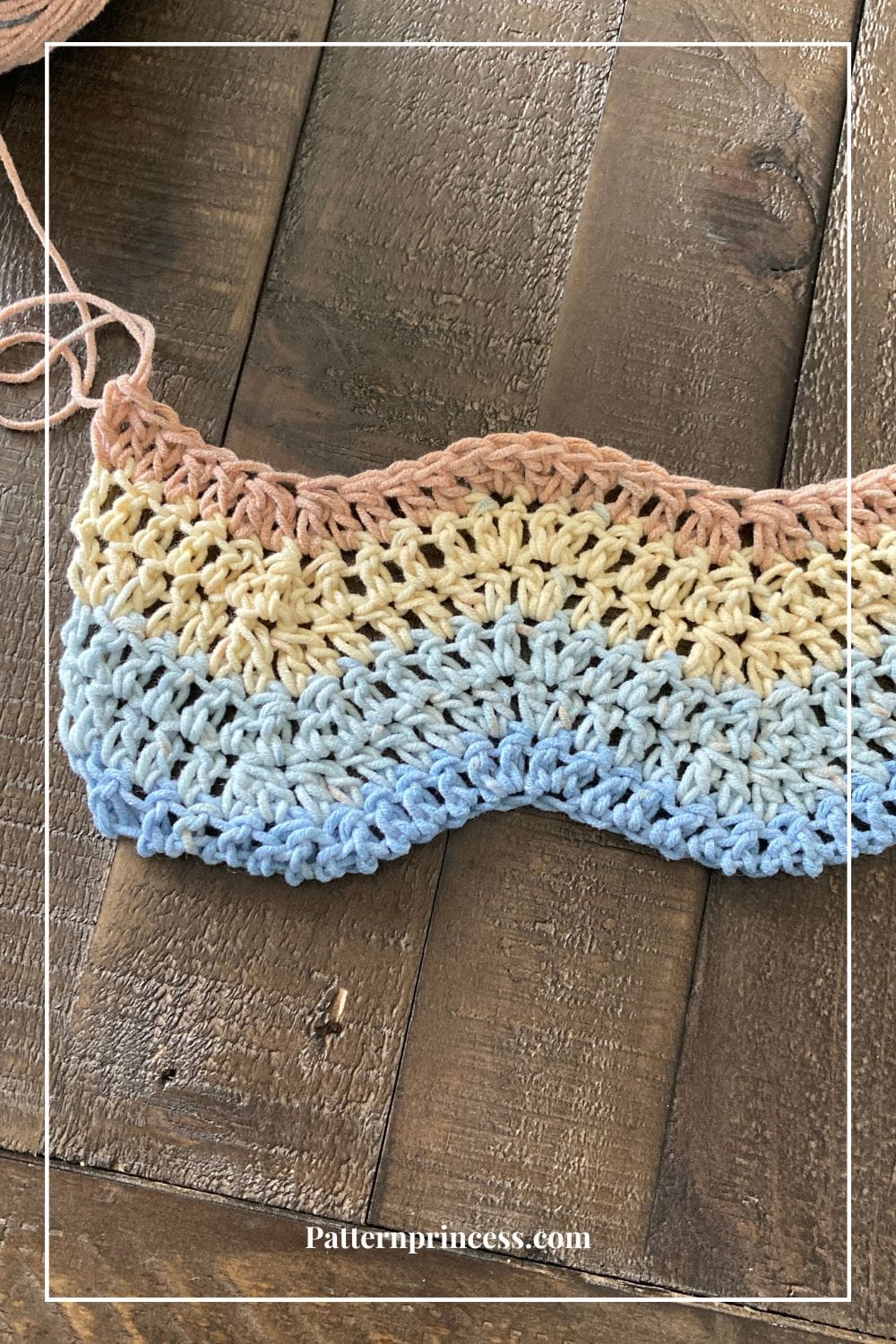
What Yarn Works with This Crochet Stitch?
The Double Crochet Ripple Stitch is a versatile crochet stitch pattern, which means it can be used with a wide range of yarn types and weights. The choice of yarn will depend on your project’s intended use and the desired outcome.
Here are some yarn options that work well:
Worsted Weight Yarn. Worsted weight yarn is a popular choice for many crochet projects. It is a medium-weight yarn that offers excellent stitch definition and is readily available in a variety of colors. This yarn is ideal for creating blankets, scarves, and home decor items.
DK (Double Knit) Yarn. DK yarn is slightly lighter than worsted weight yarn and works well for projects that require a softer and drapier fabric. It’s a great choice for lightweight and comfortable garments like shawls and wraps.
Sport Weight Yarn. If you’re looking to make delicate and lightweight items, such as baby blankets or summer accessories, sport weight yarn is a fantastic option. It creates a delicate drape and adds a touch of elegance to the ripple stitch pattern.
Bulky Weight Yarn. For those seeking a more textured and cozy look, bulky weight yarn is a perfect match. This thicker yarn will yield a quicker project and is ideal for warm scarves, cowls, and blankets.
Acrylic Yarn. Acrylic yarn is widely available, affordable, and comes in an extensive range of colors. It’s an excellent choice for beginners as it is easy to work with and forgiving. Acrylic yarn works well with the wavy pattern and is great for making durable, easy-care items.
Cotton Yarn. Cotton yarn is a fantastic option for projects that require breathability and absorbency. It’s ideal for creating washcloths, dishcloths, and lightweight summer garments.
Variegated Yarn and Changing Yarn Colors
Make this in different colors or use a variegated yarn where color changes are automatically changed throughout the skein of yarn.
Ultimately, the yarn you choose will influence the texture, drape, and overall appearance of your finished project. Before starting your crochet project, consider the item’s purpose, the season it will be used in, and the desired level of warmth and softness. Experimenting with different yarn types and colors can open up a world of creative possibilities, making your creations truly one-of-a-kind.
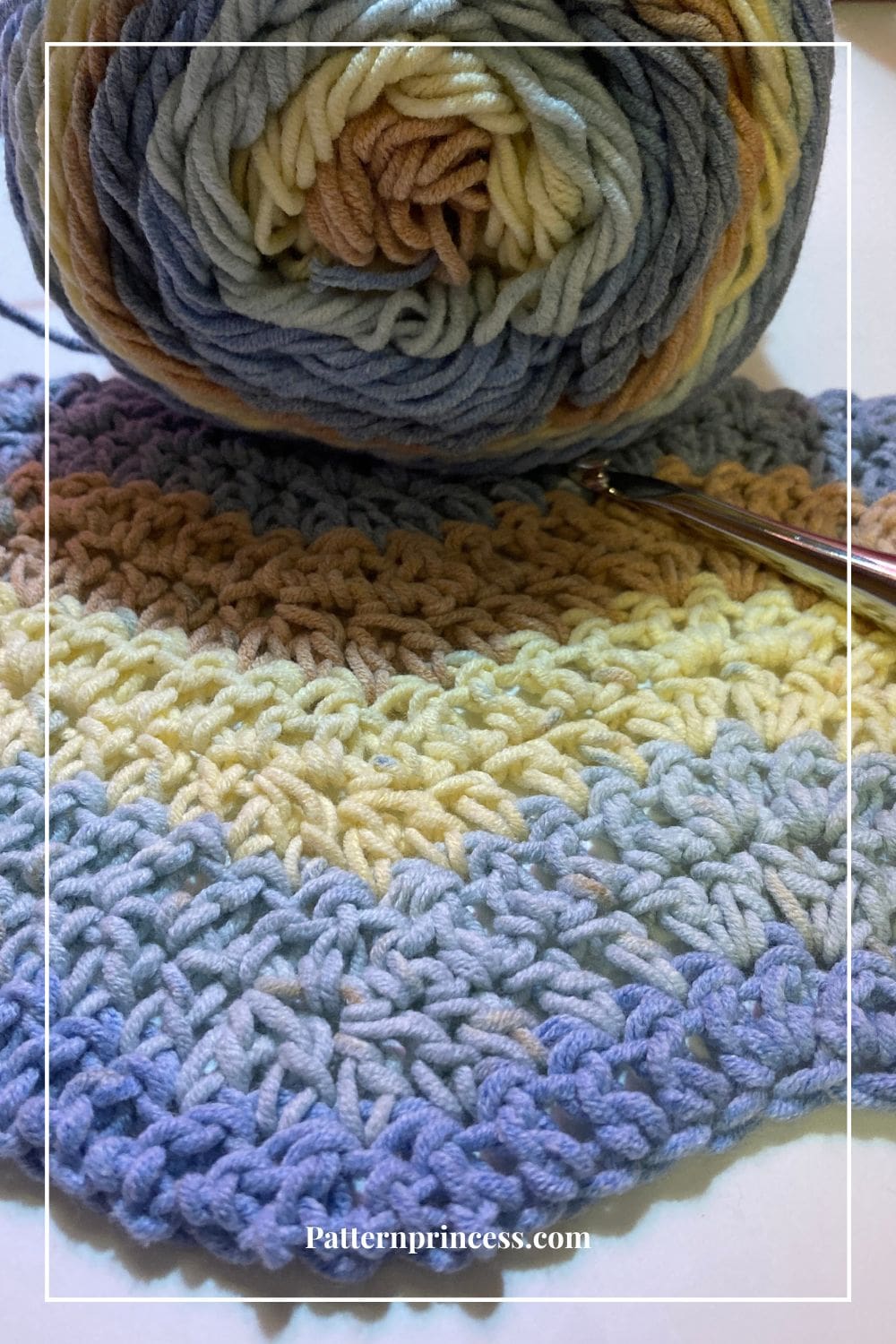
You can find a Free Easy Ripple Blanket Pattern in Three sizes using the ripple stitch.
Other Names for the Crochet Ripple Stitch
The Double Crochet Ripple Stitch is often known by several other names in the crochet community. Different crochet patterns or designers may refer to it using other terms. However, the basic stitch construction remains the same.
Some of the common alternative names for the ripple stitch include:
Chevron Stitch. This name is widely used, especially when the ripple pattern creates a chevron-like zigzag effect. You can see an example of this with the crochet chevron stitch free blanket pattern.
Wave Stitch. The term “wave stitch” is used when the pattern resembles gentle waves undulating across the fabric.
Zigzag Stitch. When the ripple stitch creates a pronounced zigzag pattern, it may be referred to as the zigzag stitch.
V-Stitch Ripple. Some patterns may refer to it as a V-stitch ripple due to the appearance of “V” shapes formed by the double crochet clusters.
Ripple Afghan. In the context of crocheting afghans or blankets, the term “ripple afghan” is often used. You can find a free pattern for the gentle river ripple blanket on the website.
Wave Afghan. Similarly, in the context of blankets, it may be called a “wave afghan” due to the wavy pattern it creates.
Round Ripple Blanket. This pattern has all the elements of the wavy ripple. However, it is worked in the round with varying numbers of points or zig zags throughout. You can find the free pattern for the 12 Point Round Ripple Baby Blanket on the website.
Pointed Chevron Stitch. This name highlights the pointed ends of the chevron waves in the pattern.
Beautiful and Versatile Crochet Technique
Remember that regardless of the name used, the essence of the stitch remains constant. The Double Crochet Ripple Stitch, in all its various names, is a beautiful and versatile crochet technique that allows you to create stunning and eye-catching projects.
So, whether you call it a ripple stitch, chevron stitch, wave stitch, or anything else, the magic of this stitch lies in the rhythmic rise and fall that adds charm and elegance to your crochet creations.
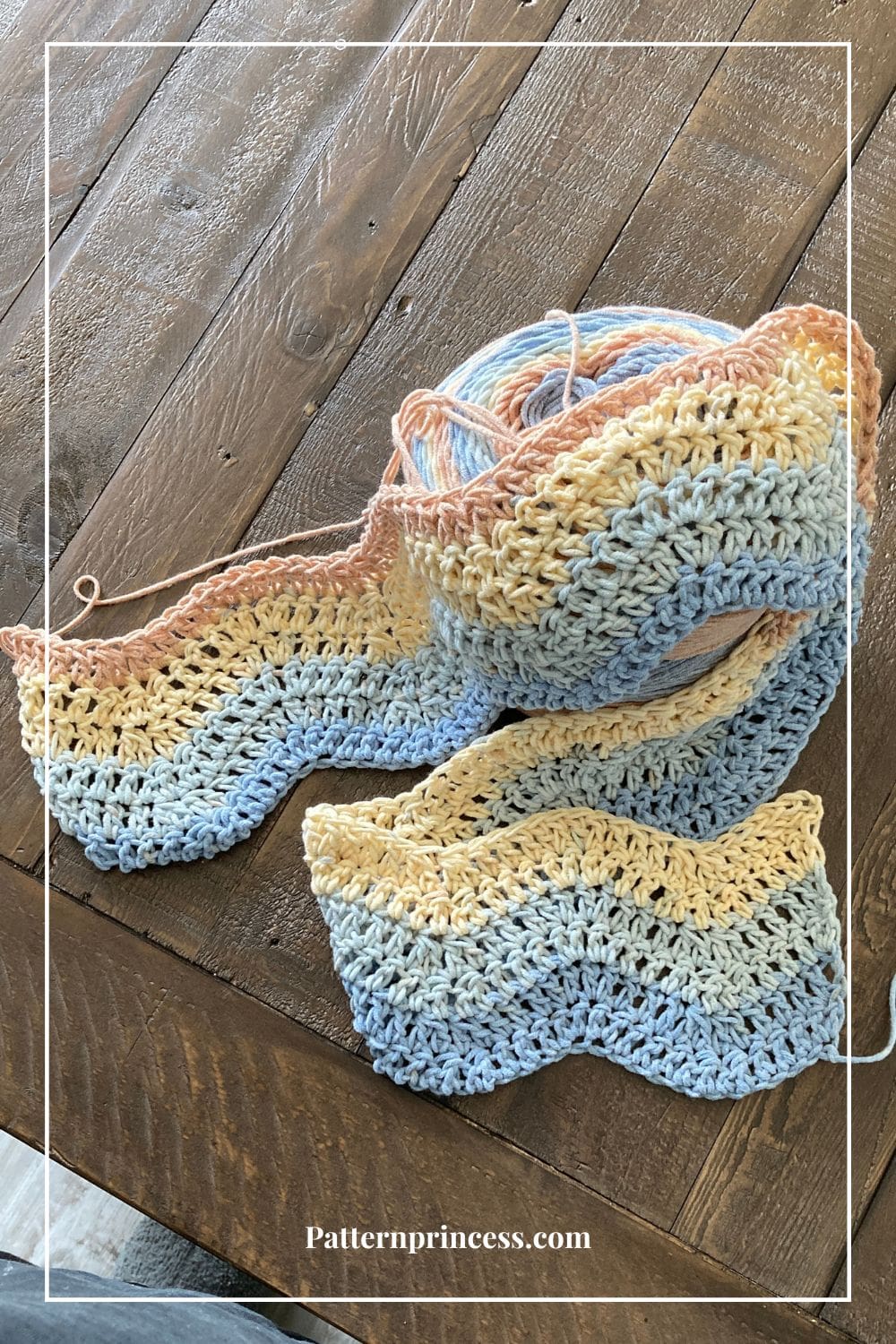
Crochet Pattern Directions: How to Crochet a Double Crochet Ripple Stitch
Skill Level
Confident Beginner. You should be able to work the Double Crochet stitch.
Size
The size of your project can easily be adjusted using multiples of 12 plus 3. That means your initial chain should be divisible by 12. Then add three more chain stitches.
Gauge
The gauge will depend on what yarn and crochet hook you use for this pattern.
Materials
Yarn. For the sample, I used Caron Cotton Cakes in Beach. However, this stitch would work nicely with any yarn weight as noted above.
Crochet Hook sized for the yarn
Tapestry Needle
Scissors
Abbreviations
- CH = Chain
- DC = Double Crochet
- DC2TOG = Double Crochet Two Together
- SK = Skip
- SP = Space
- ST = Stitch
- STs = Stitches
- [ ] = Repeat Between
Crochet Pattern Notes
Turn at the end of each row.
The chain three at the beginning of each row counts as a double crochet.
Repeat row 2 throughout the pattern.
It is quite easy to keep track of where you left off with the repeating pattern. When working the double crochet two together stitches, they create the valleys. Working two double crochet stitches in one stitch creates the soft peaks. These are the two key elements in working the simple ripple stitch.
Keep your stitches loose. Make sure to place your last stitch in the top stitch of the previous row turning chain. This helps make the sides very straight.
This pattern is written in U S Crochet Terms.
Basic Crochet Stitches Used
Double Crochet (DC). Yarn over, insert the hook through both loops and pull up a loop. Next, yarn over and pull through two loops on the hook. Lastly, yarn over again and pull through the last two loops on the hook.
Double Crochet 2 Together (DC2TOG). This decreases the stitches by one double crochet stitch each time this is worked.
First. Yarn over, insert hook into next stitch and pull up a loop. There will be three loops on the crochet hook. Yarn over, pull through two loops on the hook. There should now be just two loops left on the hook.
Second. Yarn over and insert the hook into the next stitch and pull up a loop. There will be four loops on the hook. Yarn over, pull through two loops. There should now be just three loops on the hook.
Lastly, yarn over and pull through the remaining three loops.
You can find more crochet stitch tutorials on the website too.
This first link has more of the beginner crochet stitches.
You will find dedicated blog posts to stitch tutorials using this second link as they are a bit more involved.
Crochet Pattern Directions
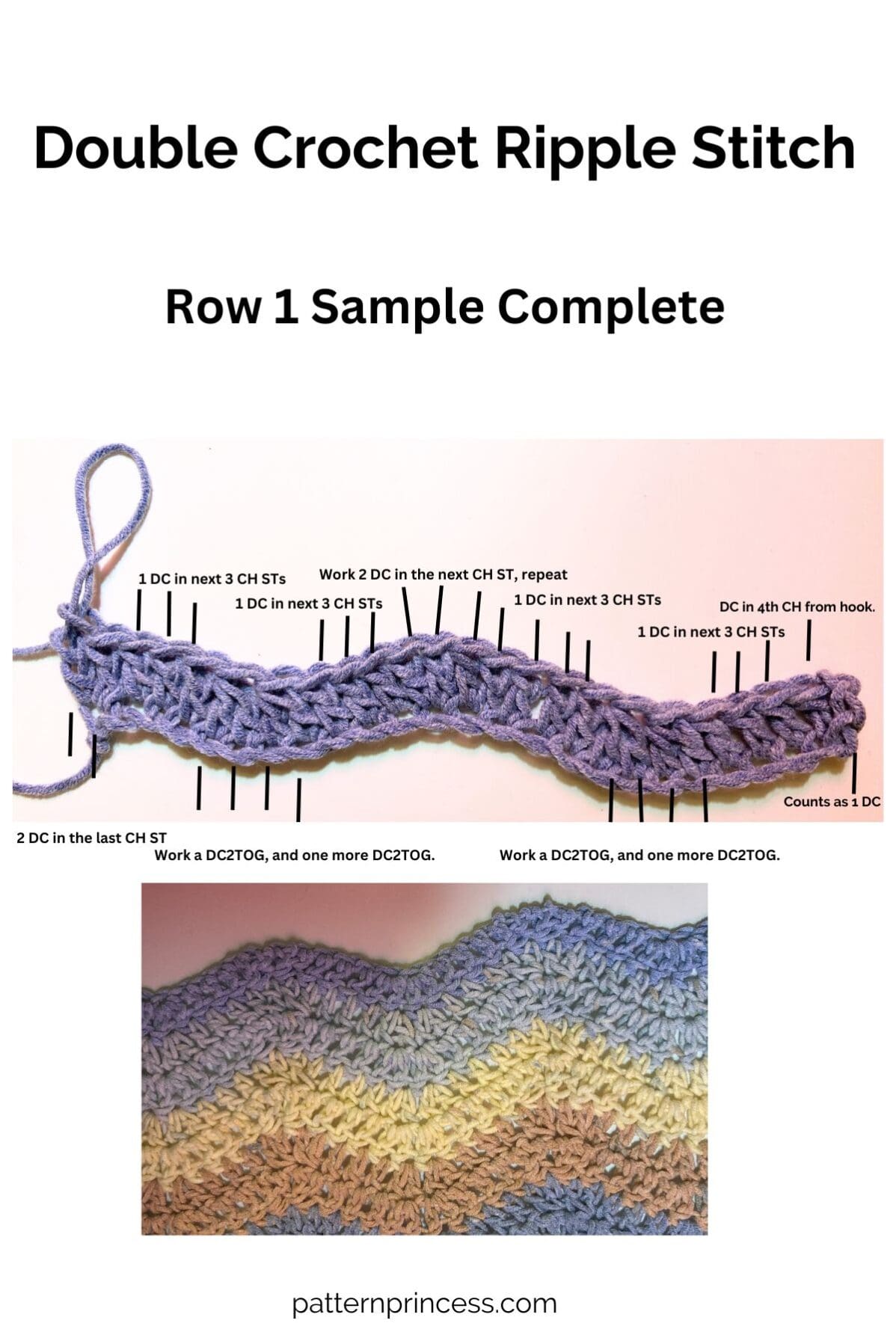
Begin
Chain your desired number of foundation chain stitches.
For the sample in the video tutorial, I used a chain of 27 stitches. Which is 12 X 2 = 24 plus 3 = 27. Use multiples of 12 plus 3 to make a different size.
Row 1
DC in 4th chain from hook. (First 3 CH STs skipped count as a DC). [1 DC in each of the next 3 CH STs. Work a DC2TOG, and one more DC2TOG. 1 DC in each of the next 3 CH STs. Work 2 DC in the next CH ST, and 2 DC in the next CH ST.] Repeat across between [ ]. End with 2 DC in the last CH ST. Turn


Row 2
CH 3 (Counts as a DC). DC in the same ST. (Another way to say this, if you count STs, it will be the 4th CH from the hook). [1 DC in each of the next 3 STs. 2DCTOG twice. 1 DC in each of the next 3 STs. 2 DC in the next ST, and 2 DC in the next ST.] Repeat across between [ ]. End with 2 DC into the top of the CH 3 turning chain from the previous row. Turn
Rows 3 and Beyond.
Repeat row 2
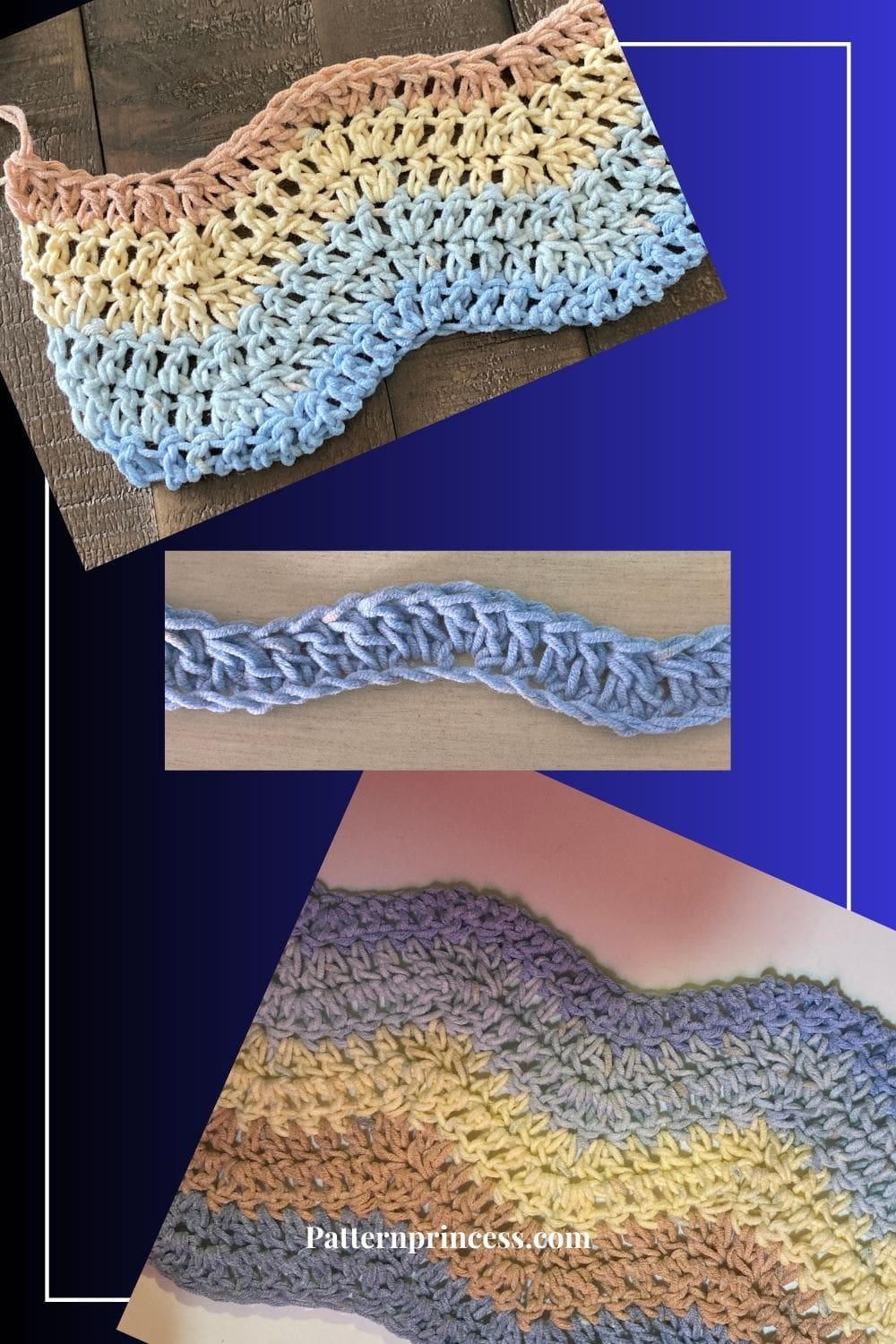
Crochet Video Tutorials
Right Hand Video
Left Hand Video
You can find other free afghan patterns using a basic stitches on the website.
How to Crochet a Double Crochet Ripple Stitch
Equipment
- Crochet Hook. Choose a size that matches your yarn weight.
- Yarn Needle
- Scissors:
Materials
- 1 skein Yarn. A worsted weight yarn works nicely with this.
Instructions
Begin
- Chain your desired number of foundation chain stitches.
- For the sample in the video tutorial, I used a chain of 27 stitches. Which is 12 X 2 = 24 plus 3 = 27. Use multiples of 12 plus 3 to make a different size.
Row 1
- DC in 4th chain from hook. (First 3 CH STs skipped count as a DC). [1 DC in each of the next 3 CH STs. Work a DC2TOG, and one more DC2TOG. 1 DC in each of the next 3 CH STs. Work 2 DC in the next CH ST, and 2 DC in the next CH ST.] Repeat across between [ ]. End with 2 DC in the last CH ST. Turn
Row 2
- CH 3 (Counts as a DC). DC in the same ST. (Another way to say this, if you count STs, it will be the 4th CH from the hook). [1 DC in each of the next 3 STs. 2DCTOG twice. 1 DC in each of the next 3 STs. 2 DC in the next ST, and 2 DC in the next ST.] Repeat across between [ ]. End with 2 DC into the top of the CH 3 turning chain from the previous row. Turn
Rows 3 and Beyond.
- Repeat row 2
Notes
CH = Chain
DC = Double Crochet
DC2TOG = Double Crochet Two Together
SK = Skip
SP = Space
ST = Stitch
STs = Stitches
[ ] = Repeat Between
Crochet Pattern Notes
Turn at the end of each row.
The chain three at the beginning of each row counts as a double crochet.
Repeat row 2 throughout the pattern.
It is quite easy to keep track of where you left off with the repeating pattern. When working the double crochet two together stitches, they create the valleys. Working two double crochet stitches in one stitch creates the soft peaks. These are the two key elements in working the simple ripple stitch.
Keep your stitches loose. Make sure to place your last stitch in the top stitch of the previous row turning chain. This helps make the sides very straight.
This pattern is written in U S Crochet Terms.
Basic Crochet Stitches Used
Double Crochet (DC). Yarn over, insert the hook through both loops and pull up a loop. Next, yarn over and pull through two loops on the hook. Lastly, yarn over again and pull through the last two loops on the hook.
Double Crochet 2 Together (DC2TOG). This decreases the stitches by one double crochet stitch each time this is worked.
First. Yarn over, insert hook into next stitch and pull up a loop. There will be three loops on the crochet hook. Yarn over, pull through two loops on the hook. There should now be just two loops left on the hook.
Second. Yarn over and insert the hook into the next stitch and pull up a loop. There will be four loops on the hook. Yarn over, pull through two loops. There should now be just three loops on the hook.
Lastly, yarn over and pull through the remaining three loops.
“Easy to follow pattern. Well written. Thank You Much!”
Joni, A Verified Etsy Buyer

You can find Victoria crocheting, quilting, and creating recipes. She has cooked in restaurants for over 20 years, including many larger parties. She learned to crochet when she was just 11 years old and has been crocheting ever since; over 50 years now. Over 40 years ago, she loved her first class in sewing and continues to hone her skills in quilting. Many have enjoyed the handmade gifts over the years. In her professional career, she has worked in management in a wide variety of businesses including higher education as a dean of a division. All the while attending college part-time to achieve her doctorate in higher education with an emphasis in e-learning.


very easy pattern to master and it looks great.